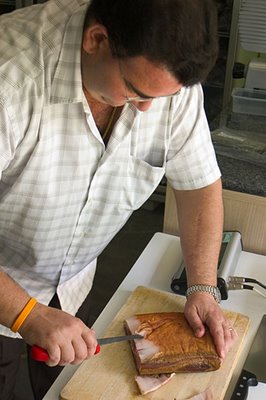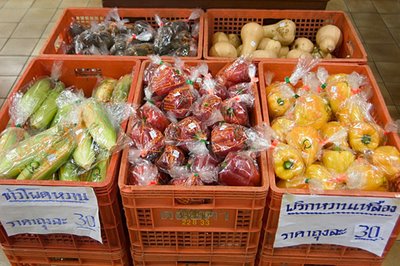ThaiDay, 15/06/06
Inspired by a delicious Italian meal, our writer tries to make it himself.
Fans of pasta and pizza in Bangkok should consider themselves particularly fortunate; the Italian Trade Commission estimates that there are currently more than 300 Italian restaurants in the capital. This is obviously a wonderful situation for diners, but what about those of us who love to cook? Does Bangkok also have the ingredients and produce to make a high quality Italian meal at home?
I first began to think about this after eating at biscotti, the Four Seasons’ Italian restaurant. When I stopped by last week, Chef Giovanni Speciale was preparing food from his home province of Puglia, also known as Apulia, the “heel” of the Italian boot. His meal began with hearty slices of grilled bread spread with ricotta forte, a pungent cheese spread, accompanied by a white globe of mozzarella di bufala topped with arugula and cherry tomatoes. This was followed by orrechiete, the “little ears” of pasta often associated with southern Italy, served with a thin sauce of broccoli, anchovies, chili and olive oil. “You cook the broccoli in the same water as the pasta, and you add just a bit of chili,” explained Chef Giovanni, who emerged from his kitchen to explain each course. The final course was bombette di maiale, thin slices of pork filled with provolone cheese, wrapped in pancetta and grilled.

Chef Giovanni Speciale explains the nuances of Puglia's major product, olive oil.
Wiping our plates clean of dessert, my companion and I were awed; the meal was simple and even rustic, but astonishingly delicious, the result of strong, confident flavors and quality ingredients; in short, I wanted to make it. Luckily, during the course of the meal, Chef Giovanni was kind enough to describe how the dishes were made. The only obstacle would be finding some of the more obscure ingredients. Obviously this would involve sourcing a fair amount of imported meats and cheeses, but when possible, I wanted to look into the growing variety of Italian-style ingredients that are being produced in Thailand today. An invaluable tool in my mission was a map provided by the Embassy of Italy, Bangkok With an Italian Heart, which describes the various Italian institutions, monuments, restaurants and shops found in Bangkok.
To recreate Chef Giovanni’s antipasti, I followed a lead indicated on the map and visited Maria Pizzeria (909-917 Silom Road,02 234 0440). Seemingly a nondescript pizza parlor from the outside, Maria is also the home of Gennaro, one of Thailand’s first producers of Italian-style cheeses. In an effort to provide cheese for his popular pizza restaurant, owner Somchai Thaveepholcharoen decided to make Italian-style cheeses himself. He sent an employee to Italy to study cheese making, imported the necessary equipment, and began producing Italian-style cheeses using Thai milk. That was 15 years ago, and today Thaveepholcharoen produces more than 10 different styles of cheese including mozzarella, ricotta, mascarpone, scamorza and most interestingly, a fresh mozzarella that contains buffalo milk. “[Buffalo milk] is very hard to get,” explained Thaveepholcharoen. “Thais aren’t interested in making it, so I can’t get a lot of it.” It is this fresh cheese that I have come by to pick up, and Thaveepholcharoen mentions that Gennaro products are also available at some branches of Tops, Villa and Foodland, but he has no problem with people coming to the restaurant simply to buy cheese to go.
My next stop was at another business featured on the map, Food DItalia (160/1 Sukhumvit Soi 33, 02 259 9549). Owned by Roberto Brivio, a friendly native of Milan, Food DItalia is an importer of Italian food products into Thailand. Though the vast majority of his business is conducted through hotels and restaurants, Brivio is more than happy to serve individuals who are willing to come to his showroom. “I like being here to explain the products to customers,” explains Brivio. I describe the meal I plan to make and he is able to provide every last ingredient including smoked pancetta, which Brivio slices paper-thin, a “spicy” provolone cheese known as auricchio, and ricotta dura di pecora, a sheep’s milk cheese from Puglia. “People in Puglia use this cheese on pasta instead of parmesan,” explained Brivio, as he gave me a piece to taste. The cheese was delicious, and was just one of the products that I didn’t previously realize was available in Bangkok. As an added bonus, I am able to take Brivio’s last bag of fresh orrechiete; a vast improvement over the dried stuff generally available at Bangkok’s supermarkets.

Food DItalia owner Roberto Brivio slices off paper thin slices of prosciutto.
I had mentioned to Roberto that I was still in need of wine, preferably something from Puglia, and he suggested I visit ItalAsia’s showroom at All Seasons Place (Wireless Road, 02 685 3862). ItalAsia is Thailand’s oldest importer of Italian goods, and claims to have the largest selection of Italian wines. I stopped by the small shop, and after some deliberation, picked up a 1.5 litre bottle of Sangiovese di Puglia, a dry red that would hopefully go well with the slightly spicy pasta course and the grilled meat with its strong cheese filling.
I still needed a few odds and ends, and stopped by Villa, Bangkok’s standby for imported groceries. For better or worse, Villa’s stock of specialty food items is unmatched, and I needed a few items that could only be found there. I picked up some arugula from Rai Pluk Rak, Thailand’s first organic farm, as well as a jar of oil-preserved anchovies from Siam Fishery, a Thai brand. I also bought a loaf of country-style sourdough bread from La Boulange, Bangkok’s best bakery, which sells its products at Villa.
My final stop was at my favorite store in Bangkok: Doi Kham (101 Kamphaeng Phet Road, 02 279 1551). This tiny supermarket located near the Or Tor Kor Market stocks a truly impressive variety of Western-style produce grown in northern Thailand under the auspices of the Royal Project Foundation. The fruits and vegetables sold at Doi Kham are high quality, pesticide-free and include such Italian staples as eggplants, artichokes, fennel, zucchini, bell peppers and radicchio, as well as fresh herbs such as sage, Italian parsley, oregano and thyme. I picked up some young broccoli and juicy cherry tomatoes—essential ingredients for the pasta dish, and made my way home.

Doi Kham stocks an impressive variety of produce.
The next day I invited some friends over and made my Apulian meal. Relying on Chef Giovanni’s descriptions and my own experience making Italian food, the cooking went relatively smoothly. The antipasti of grilled bread, arugula salad and mozzarella was a hit, the creamy buffalo cheese winning over even those who normally don’t like dairy products. The fresh pasta of the next course was deliciously tender, and was only improved by the tender Doi Kham broccoli and tomatoes and the strong flavours of the Thai anchovies and dried chili. The Apulian wine stood up to the food well, surviving both the spicy pasta and the strong provolone in the grilled pork.
In the end my Apulian meal wasn’t necessarily cheaper or even more delicious than my meal at biscotti, but for someone who loves to cook, it was a pleasure to discover the diversity of products available in Bangkok. And although sourcing these ingredients may have involved a considerable amount of travel, it was worth it considering the quality of both the imported and the domestically produced products. With resources such as these, surely it’s only a matter of time before Italian food in Bangkok moves from the restaurant into the home.












